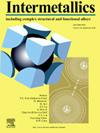Machine learning for hot deformation flow stress prediction and dynamic recrystallization in Fe24.75Ni19.8Co9.9Cr14.85Al10.9Mn14.85Si4.95 high-entropy alloy
IF 4.8
2区 材料科学
Q2 CHEMISTRY, PHYSICAL
引用次数: 0
Abstract
In this study, a machine learning model based on a traditional support vector machine (BKA-SVR), optimized by the Black Kite Algorithm, was established for the first time and used to predict the flow stress value. Compared to the traditional SCAT constitutive model, the BKA-SVR model provides a more accurate flow stress prediction. The mean square correlation coefficient is 0.99799, the average absolute error is 5.4826, and the average absolute relative error is 12.02 %. In the context of small sample predictions, the BKA-SVR model still demonstrates high accuracy in flow stress prediction: R2 is 0.99527, MAE is 6.0667, and MAPE is 12.76 %. According to the hot processing map that utilizes different stability criteria, the prediction based on Murty's instability criterion is found to be more applicable. Through a coupled analysis of energy dissipation and the instability criterion, the optimal hot working process was determined to be at a deformation temperature of 1100 °C and a strain rate of 0.001 s−1. Under this process parameter, the energy dissipation efficiency (η) is approximately 56 %, and there is no risk of instability. Additionally, a microscopic analysis of different regions with varying η values reveals that as the η value increases, the degree of dynamic recrystallization (DDRX) gradually increases.
机器学习用于Fe24.75Ni19.8Co9.9Cr14.85Al10.9Mn14.85Si4.95高熵合金热变形流应力预测和动态再结晶
本研究首次建立了基于传统支持向量机(BKA-SVR)并经黑风筝算法优化的机器学习模型,用于预测流动应力值。与传统SCAT本构模型相比,BKA-SVR模型提供了更准确的流变应力预测。均方相关系数为0.99799,平均绝对误差为5.4826,平均绝对相对误差为12.02%。在小样本预测情况下,BKA-SVR模型在预测流变应力方面仍然具有较高的准确性,R2为0.99527,MAE为6.0667,MAPE为12.76%。根据采用不同稳定性判据的热加工图,发现基于Murty不稳定性判据的预测更为适用。通过能量耗散和失稳准则的耦合分析,确定了最佳热加工工艺为变形温度为1100℃,应变速率为0.001 s−1。在此工艺参数下,能量耗散效率(η)约为56%,且无失稳风险。此外,对不同η值区域的微观分析表明,随着η值的增大,动态再结晶程度(DDRX)逐渐增大。
本文章由计算机程序翻译,如有差异,请以英文原文为准。
求助全文
约1分钟内获得全文
求助全文
来源期刊

Intermetallics
工程技术-材料科学:综合
CiteScore
7.80
自引率
9.10%
发文量
291
审稿时长
37 days
期刊介绍:
This journal is a platform for publishing innovative research and overviews for advancing our understanding of the structure, property, and functionality of complex metallic alloys, including intermetallics, metallic glasses, and high entropy alloys.
The journal reports the science and engineering of metallic materials in the following aspects:
Theories and experiments which address the relationship between property and structure in all length scales.
Physical modeling and numerical simulations which provide a comprehensive understanding of experimental observations.
Stimulated methodologies to characterize the structure and chemistry of materials that correlate the properties.
Technological applications resulting from the understanding of property-structure relationship in materials.
Novel and cutting-edge results warranting rapid communication.
The journal also publishes special issues on selected topics and overviews by invitation only.
 求助内容:
求助内容: 应助结果提醒方式:
应助结果提醒方式:


